Dosing & Uses
Dosage Forms & Strengths
oral capsule (undecanoate): Schedule III
- 100mg (Kyzatrex)
- 112.5mg (Tlando)
- 150mg (Kyzatrex)
- 158mg (Jatenzo)
- 198mg (Jatenzo)
- 200mg (Kyzatrex)
- 237mg (Jatenzo)
injectable solution (cypionate): Schedule III
- 100mg/mL (Depo-Testosterone)
- 200mg/mL (Depo-Testosterone)
injectable solution (enanthate): Schedule III
- 50 mg/0.5mL (Xyosted)
- 75 mg/0.5mL (Xyosted)
- 100 mg/0.5mL (Xyosted)
- 200mg/mL (generic)
injectable solution (undecanoate): Schedule III
- 750mg/3mL (Aveed)
pellet implant: Schedule III
- 75mg (Testopel)
- 12.5mg, 25mg, 37.5mg, 50mg (generic)
Hypogonadism
Primary hypogonadism (congenital or acquired): Testicular failure due to conditions such as cryptorchidism, bilateral torsion, orchitis, vanishing testis syndrome, orchiectomy, Klinefelter Syndrome, chemotherapy, or toxic damage from alcohol or heavy metals; these men usually have low serum testosterone concentrations and gonadotropins (FSH, LH) above normal range
Hypogonadotropic hypogonadism (congenital or acquired): Gonadotropin or luteinizing hormone-releasing hormone (LHRH) deficiency or pituitary-hypothalamic injury from tumors, trauma, or radiation; these men have low testosterone serum concentrations but have gonadotropins in the normal or low range
Testosterone cypionate: 50-400 mg IM every 2-4 weeks
Testosterone enanthate (generic): 50-400 mg IM every 2-4 weeks
Testosterone undecanoate (restricted availability): 750 mg IM initial dose, repeat after 4 weeks, and then q10wk thereafter
Pellet: 150-450 mg SC every 3-6 months; 150 mg of pellet approximately equivalent to 25 mg of testosterone propionate weekly
Xyosted
- Starting dose: 75 mg SC qWeek
- Adjust dose based upon total testosterone minimum (trough) concentrations (Cmin) (measured 7 days after most recent dose) obtained following 6 weeks of dosing and periodically thereafter
- Normal total testosterone Cmin during treatment: 350-650 ng/dL
- Maintain same dose if total testosterone Cmin ≥350 ng/dL and <650 ng/dL
- Total testosterone Cmin ≥650 ng/dL: Decrease dose by 25 mg
- Total testosterone Cmin <350 ng/dL: Increase dose by 25 mg
Jatenzo
- Starting dose: 237 mg PO BID with food
- Adjust dosage according to serum testosterone levels 6 hr after morning dose
- Wait 7 days after starting treatment or dosage adjustment before checking the serum testosterone levels; thereafter, periodically monitor serum testosterone levels 6 hr after morning dose
- Adjust dose based on testosterone level as follows
-
<425 ng/dL
- Current BID dose 158 mg: Increase to 198 mg BID
- Current BID dose 198 mg: Increase to 237 mg BID
- Current BID dose 237 mg: Increase to 316 mg (two 158-mg cap) BID
- Current BID dose 316 mg: Increase to 396 mg (two 198-mg cap) BID
-
425-970 ng/dL
- No dose change
-
>970 ng/dL
- Current BID dose 396 mg: Decrease to 316 mg BID
- Current BID dose 316 mg: Decrease to 237 mg BID
- Current BID dose 237 mg: Decrease to 198 mg BID
- Current BID dose 198 mg: Decrease to 158 mg BID
- Current BID dose 158 mg: Discontinue treatment
Tlando
- Starting dose: 225 mg PO BID with food
- Based on serum testosterone levels, continue, or discontinue therapy H5
- Monitor serum testosterone (8-9 hr after morning dose) 3-4 weeks after initiating, and periodically thereafter
- Serum testosterone 300-1080 ng/dL: Continue
- Serum testosterone <300 ng/dL: Discontinue
- Serum testosterone >1080 ng/dL: Discontinue
Kyzatrex
- Individualize dosage based on patient’s serum testosterone level response to drug
- Starting dose: 200 mg PO BID (in AM and in PM) with food
- Check serum testosterone levels 7 days after starting treatment or after dosage adjustment, 3- hr after AM dose; thereafter, monitor periodically
- Minimum dose: 100 mg PO qAM
- Maximum dose: 400 mg PO BID
- Total daily doses (TDD) >100 mg: Divide TDD dose equally in AM and PM
- Adjust dose based on testosterone level as follows
-
<460 ng/dL
- Current dose 100 mg qAM: Increase to 100 mg BID
- Current dose 100 mg BID: Increase to 200 mg BID
- Current dose 200 mg BID: Increase to 300 mg BID
- Current dose 300 mg BID: Increase to 400 mg BID
-
460-971 ng/dL
- No dosage change
-
>971 ng/dL
- Current dose 400 mg BID: Decrease to 300 mg BID
- Current dose 300 mg BID: Decrease to 200 mg BID
- Current dose 200 mg BID: Decrease to 100 mg BID
- Current dose 100 mg qAM: Discontinue
Delayed Puberty in Males
Testosterone enanthate (generic): 50-200 mg IM every 2-4 weeks for 4-6 months
Inoperable Mammary Cancer in Women
Testosterone enanthate (generic): 200-400 mg IM every 2-4 weeks
Androgen Deficiency in HIV+ Patients (Orphan)
Physiologic testosterone replacement in androgen-deficient HIV+ patients with associated weight loss
Orphan sponsor
- Watson Laboratories, Research Park, 417 Wakara Way, Salt Lake City, UT 8410
Delayed Growth (Orphan)
Treatment of constitutional delay in growth and puberty in adolescent boys aged 14-17 years (testosterone undecanoate)
Orphan sponsor
- SOV Therapeutics, Inc, 101 Guymon Court, Morrisville, NC 27560
Dosing Considerations
Tlando and Kyzatrex: Not substitutable with other oral testosterone undecanoate products
Before initiating
- Measure serum testosterone in morning on at least 2 separate days and that these concentrations are below the normal range to confirm hypogonadism diagnosis
Limitation of use
- Jatenzo, Tlando, Xyosted, Kyzatrex: Safety and efficacy males aged <18 years old not established
Dosage Forms & Strengths
injectable solution (cypionate): Schedule III
- 100mg/mL (Depo-Testosterone)
- 200mg/mL (Depo-Testosterone)
injectable solution (enanthate): Schedule III
- 200mg/mL (generic)
injectable solution (undecanoate): Schedule III
- 250mg/mL (Aveed)
pellet implant: Schedule III
- 75mg (Testopel)
- 12.5mg, 25mg, 37.5mg, 50mg (generic)
Hypogonadism
<12 years
- Safety and efficacy not established
≥12 years
- Testosterone cypionate: 50-400 mg IM every 2-4 weeks
- Testosterone enanthate (generic): 50-400 mg IM every 2-4 weeks
- Pellet: 150-450 mg SC every 3-6 months; 150 mg of pellet approximately equivalent to 25 mg of testosterone propionate weekly
Delayed Puberty in Males
<12 years
- Safety and efficacy not established
≥12 years
- 50-200 mg IM every 2-4 weeks for 4-6 months
Dosing Considerations
Limitations of use
- Aveed: Safety and efficacy not established in adult males with “age-related hypogonadism” (also referred as “late-onset hypogonadism”) and males aged <18 yr
- Jatenzo, Tlando, Xyosted, Kyzatrex: Safety and efficacy not established in males aged <18 yr
Interactions
Interaction Checker
No Results

Contraindicated
Serious - Use Alternative
Significant - Monitor Closely
Minor

Contraindicated (1)
- cabotegravir
testosterone will decrease the level or effect of cabotegravir by increasing metabolism. Contraindicated. Cabotegravir is metabolized by UGT1A1 and UGT1A9. Strong UGT1A1 or UGT1A9 inducers decrease cabotegravir systemic exposure, thereby increasing potential for loss of virologic response.
Serious - Use Alternative (8)
- cyclosporine
testosterone increases effects of cyclosporine by decreasing metabolism. Avoid or Use Alternate Drug.
- lasmiditan
lasmiditan increases levels of testosterone by P-glycoprotein (MDR1) efflux transporter. Avoid or Use Alternate Drug.
- lonafarnib
testosterone will increase the level or effect of lonafarnib by affecting hepatic/intestinal enzyme CYP3A4 metabolism. Avoid or Use Alternate Drug. If coadministration of lonafarnib (a sensitive CYP3A substrate) with weak CYP3A inhibitors is unavoidable, reduce to, or continue lonafarnib at starting dose. Closely monitor for arrhythmias and events (eg, syncope, heart palpitations) since lonafarnib effect on QT interval is unknown.
- pexidartinib
testosterone and pexidartinib both increase Other (see comment). Avoid or Use Alternate Drug. Pexidartinib can cause hepatotoxicity. Avoid coadministration of pexidartinib with other products know to cause hepatoxicity.
- pretomanid
testosterone, pretomanid. Either increases toxicity of the other by Other (see comment). Avoid or Use Alternate Drug. Comment: Pretomanid regimen associated with hepatotoxicity. Avoid alcohol and hepatotoxic agents, including herbal supplements and drugs other than bedaquiline and linezolid.
- sotorasib
sotorasib will decrease the level or effect of testosterone by P-glycoprotein (MDR1) efflux transporter. Avoid or Use Alternate Drug. If use is unavoidable, refer to the prescribing information of the P-gp substrate for dosage modifications.
- tepotinib
tepotinib will increase the level or effect of testosterone by P-glycoprotein (MDR1) efflux transporter. Avoid or Use Alternate Drug. If concomitant use unavoidable, reduce the P-gp substrate dosage if recommended in its approved product labeling.
- warfarin
testosterone increases effects of warfarin by anticoagulation. Avoid or Use Alternate Drug.
Monitor Closely (29)
- atogepant
testosterone will increase the level or effect of atogepant by affecting hepatic/intestinal enzyme CYP3A4 metabolism. Use Caution/Monitor.
- avapritinib
testosterone will increase the level or effect of avapritinib by affecting hepatic/intestinal enzyme CYP3A4 metabolism. Use Caution/Monitor.
- axitinib
testosterone increases levels of axitinib by affecting hepatic/intestinal enzyme CYP3A4 metabolism. Use Caution/Monitor.
- berotralstat
berotralstat will increase the level or effect of testosterone by P-glycoprotein (MDR1) efflux transporter. Use Caution/Monitor. Monitor or titrate P-gp substrate dose if coadministered.
- carbamazepine
testosterone increases toxicity of carbamazepine by decreasing metabolism. Use Caution/Monitor.
- danicopan
danicopan will increase the level or effect of testosterone by P-glycoprotein (MDR1) efflux transporter. Use Caution/Monitor. Danicopan increases plasma concentrations of P-gp substrates; consider dose reduction of P-gp substrates where minimal concentration changes may lead to serious adverse reactions.
- elagolix
elagolix will increase the level or effect of testosterone by P-glycoprotein (MDR1) efflux transporter. Use Caution/Monitor.
- eliglustat
eliglustat increases levels of testosterone by P-glycoprotein (MDR1) efflux transporter. Modify Therapy/Monitor Closely. Monitor therapeutic drug concentrations, as indicated, or consider reducing the dosage of the P-gp substrate and titrate to clinical effect.
- finerenone
testosterone will increase the level or effect of finerenone by affecting hepatic/intestinal enzyme CYP3A4 metabolism. Modify Therapy/Monitor Closely. Monitor serum potassium during initiation and dosage adjustment of either finererone or weak CYP3A4 inhibitors. Adjust finererone dosage as needed.
- flibanserin
testosterone will increase the level or effect of flibanserin by affecting hepatic/intestinal enzyme CYP3A4 metabolism. Use Caution/Monitor. Increased flibanserin adverse effects may occur if coadministered with multiple weak CYP3A4 inhibitors.
- fostamatinib
fostamatinib will increase the level or effect of testosterone by P-glycoprotein (MDR1) efflux transporter. Use Caution/Monitor. Concomitant use of fostamatinib may increase concentrations of P-gp substrates. Monitor for toxicities of the P-gp substrate drug that may require dosage reduction when given concurrently with fostamatinib.
- glecaprevir/pibrentasvir
glecaprevir/pibrentasvir will increase the level or effect of testosterone by P-glycoprotein (MDR1) efflux transporter. Use Caution/Monitor.
- insulin degludec
testosterone increases effects of insulin degludec by pharmacodynamic synergism. Modify Therapy/Monitor Closely. Androgens may decrease blood glucose and, therefore, may necessitate a decrease in the dose of antidiabetic medication.
- insulin degludec/insulin aspart
testosterone increases effects of insulin degludec/insulin aspart by pharmacodynamic synergism. Modify Therapy/Monitor Closely. Androgens may decrease blood glucose and, therefore, may necessitate a decrease in the dose of antidiabetic medication.
- insulin inhaled
testosterone increases effects of insulin inhaled by pharmacodynamic synergism. Modify Therapy/Monitor Closely. Androgens may decrease blood glucose and, therefore, may necessitate a decrease in the dose of antidiabetic medication.
- isavuconazonium sulfate
testosterone will increase the level or effect of isavuconazonium sulfate by affecting hepatic/intestinal enzyme CYP3A4 metabolism. Use Caution/Monitor.
- istradefylline
istradefylline will increase the level or effect of testosterone by P-glycoprotein (MDR1) efflux transporter. Use Caution/Monitor. Istradefylline 40 mg/day increased peak levels and AUC of P-gp substrates in clinical trials. Consider dose reduction of sensitive P-gp substrates.
- ivacaftor
ivacaftor increases levels of testosterone by P-glycoprotein (MDR1) efflux transporter. Use Caution/Monitor. Ivacaftor and its M1 metabolite has the potential to inhibit P-gp; may significantly increase systemic exposure to sensitive P-gp substrates with a narrow therapeutic index.
testosterone increases levels of ivacaftor by affecting hepatic/intestinal enzyme CYP3A4 metabolism. Use Caution/Monitor. Monitor when coadministered with weak CYP3A4 inhibitors . - lemborexant
testosterone will increase the level or effect of lemborexant by affecting hepatic/intestinal enzyme CYP3A4 metabolism. Modify Therapy/Monitor Closely. Lower nightly dose of lemborexant recommended if coadministered with weak CYP3A4 inhibitors. See drug monograph for specific dosage modification.
- lomitapide
testosterone increases levels of lomitapide by affecting hepatic/intestinal enzyme CYP3A4 metabolism. Use Caution/Monitor. Lomitapide dose should not exceed 30 mg/day.
- lonafarnib
lonafarnib will increase the level or effect of testosterone by P-glycoprotein (MDR1) efflux transporter. Modify Therapy/Monitor Closely. Lonafarnib is a weak P-gp inhibitor. Monitor for adverse reactions if coadministered with P-gp substrates where minimal concentration changes may lead to serious or life-threatening toxicities. Reduce P-gp substrate dose if needed.
- midazolam intranasal
testosterone will increase the level or effect of midazolam intranasal by affecting hepatic/intestinal enzyme CYP3A4 metabolism. Use Caution/Monitor. Coadministration of mild CYP3A4 inhibitors with midazolam intranasal may cause higher midazolam systemic exposure, which may prolong sedation.
- mipomersen
mipomersen, testosterone. Either increases toxicity of the other by Other (see comment). Use Caution/Monitor. Comment: Both drugs have potential to increase hepatic enzymes; monitor LFTs.
- ponatinib
ponatinib increases levels of testosterone by P-glycoprotein (MDR1) efflux transporter. Use Caution/Monitor.
- sarecycline
sarecycline will increase the level or effect of testosterone by P-glycoprotein (MDR1) efflux transporter. Use Caution/Monitor. Monitor for toxicities of P-gp substrates that may require dosage reduction when coadministered with P-gp inhibitors.
- stiripentol
stiripentol will increase the level or effect of testosterone by P-glycoprotein (MDR1) efflux transporter. Modify Therapy/Monitor Closely. Consider reducing the dose of P-glycoprotein (P-gp) substrates, if adverse reactions are experienced when administered concomitantly with stiripentol.
- tazemetostat
testosterone will increase the level or effect of tazemetostat by affecting hepatic/intestinal enzyme CYP3A4 metabolism. Use Caution/Monitor.
- tinidazole
testosterone will increase the level or effect of tinidazole by affecting hepatic/intestinal enzyme CYP3A4 metabolism. Use Caution/Monitor.
- tucatinib
tucatinib will increase the level or effect of testosterone by P-glycoprotein (MDR1) efflux transporter. Use Caution/Monitor. Consider reducing the dosage of P-gp substrates, where minimal concentration changes may lead to serious or life-threatening toxicities.
Minor (39)
- acarbose
testosterone increases effects of acarbose by pharmacodynamic synergism. Minor/Significance Unknown.
- androstenedione
androstenedione increases effects of testosterone by pharmacodynamic synergism. Minor/Significance Unknown.
- budesonide
testosterone, budesonide. Either increases effects of the other by pharmacodynamic synergism. Minor/Significance Unknown. May enhance edema formation.
- chlorpropamide
testosterone increases effects of chlorpropamide by pharmacodynamic synergism. Minor/Significance Unknown.
- cortisone
testosterone, cortisone. Either increases effects of the other by pharmacodynamic synergism. Minor/Significance Unknown. May enhance edema formation.
- deflazacort
testosterone, deflazacort. Either increases effects of the other by pharmacodynamic synergism. Minor/Significance Unknown. May enhance edema formation.
- dexamethasone
testosterone, dexamethasone. Either increases effects of the other by pharmacodynamic synergism. Minor/Significance Unknown. May enhance edema formation.
- epoetin alfa
testosterone increases effects of epoetin alfa by pharmacodynamic synergism. Minor/Significance Unknown. Androgens may be used to decrease necessary dose of epoetin alfa.
- fludrocortisone
testosterone, fludrocortisone. Either increases effects of the other by pharmacodynamic synergism. Minor/Significance Unknown. May enhance edema formation.
- glimepiride
testosterone increases effects of glimepiride by pharmacodynamic synergism. Minor/Significance Unknown.
- glipizide
testosterone increases effects of glipizide by pharmacodynamic synergism. Minor/Significance Unknown.
- glyburide
testosterone increases effects of glyburide by pharmacodynamic synergism. Minor/Significance Unknown.
- hydrocortisone
testosterone, hydrocortisone. Either increases effects of the other by pharmacodynamic synergism. Minor/Significance Unknown. May enhance edema formation.
- insulin aspart
testosterone increases effects of insulin aspart by pharmacodynamic synergism. Minor/Significance Unknown.
- insulin detemir
testosterone increases effects of insulin detemir by pharmacodynamic synergism. Minor/Significance Unknown.
- insulin glargine
testosterone increases effects of insulin glargine by pharmacodynamic synergism. Minor/Significance Unknown.
- insulin glulisine
testosterone increases effects of insulin glulisine by pharmacodynamic synergism. Minor/Significance Unknown.
- insulin lispro
testosterone increases effects of insulin lispro by pharmacodynamic synergism. Minor/Significance Unknown.
- insulin NPH
testosterone increases effects of insulin NPH by pharmacodynamic synergism. Minor/Significance Unknown.
- insulin regular human
testosterone increases effects of insulin regular human by pharmacodynamic synergism. Minor/Significance Unknown.
- metformin
testosterone increases effects of metformin by pharmacodynamic synergism. Minor/Significance Unknown.
- methylprednisolone
testosterone, methylprednisolone. Either increases effects of the other by pharmacodynamic synergism. Minor/Significance Unknown. May enhance edema formation.
- miglitol
testosterone increases effects of miglitol by pharmacodynamic synergism. Minor/Significance Unknown.
- nateglinide
testosterone increases effects of nateglinide by pharmacodynamic synergism. Minor/Significance Unknown.
- pioglitazone
testosterone increases effects of pioglitazone by pharmacodynamic synergism. Minor/Significance Unknown.
- prednisolone
testosterone, prednisolone. Either increases effects of the other by pharmacodynamic synergism. Minor/Significance Unknown. May enhance edema formation.
- prednisone
testosterone, prednisone. Either increases effects of the other by pharmacodynamic synergism. Minor/Significance Unknown. May enhance edema formation.
- repaglinide
testosterone increases effects of repaglinide by pharmacodynamic synergism. Minor/Significance Unknown.
- rosiglitazone
testosterone increases effects of rosiglitazone by pharmacodynamic synergism. Minor/Significance Unknown.
- ruxolitinib
testosterone will increase the level or effect of ruxolitinib by affecting hepatic/intestinal enzyme CYP3A4 metabolism. Minor/Significance Unknown.
- ruxolitinib topical
testosterone will increase the level or effect of ruxolitinib topical by affecting hepatic/intestinal enzyme CYP3A4 metabolism. Minor/Significance Unknown.
- saw palmetto
saw palmetto decreases effects of testosterone by pharmacodynamic antagonism. Minor/Significance Unknown.
- saxagliptin
testosterone increases effects of saxagliptin by pharmacodynamic synergism. Minor/Significance Unknown.
- sitagliptin
testosterone increases effects of sitagliptin by pharmacodynamic synergism. Minor/Significance Unknown.
- tacrolimus
testosterone increases effects of tacrolimus by decreasing metabolism. Minor/Significance Unknown.
- tolazamide
testosterone increases effects of tolazamide by pharmacodynamic synergism. Minor/Significance Unknown.
- tolbutamide
testosterone increases effects of tolbutamide by pharmacodynamic synergism. Minor/Significance Unknown.
- triamcinolone acetonide injectable suspension
testosterone, triamcinolone acetonide injectable suspension. Either increases effects of the other by pharmacodynamic synergism. Minor/Significance Unknown. May enhance edema formation.
- vildagliptin
testosterone increases effects of vildagliptin by pharmacodynamic synergism. Minor/Significance Unknown.
Adverse Effects
1-10%
Kyzatrex
- Increased hemoglobin (4.5%)
- Hypertension (2.6%)
- Increased PSA (2.6%)
- Headache (1.9%)
Tlando
- Blood prolactin increased (6.3%)
- Hypertension (5.1%)
- Hematocrit increased (4.3%)
- Upper respiratory tract infection (3.6%)
- Weight increased (2.1%)
- Headache (2.1%)
- Musculoskeletal pain (2.1%)
Frequency Not Defined
Acne
Abnormal dreams
Aggressive behavior
Alopecia
Anaphylaxis
Anger
Amnesia
Anxiety
Bladder irritability
Breast soreness
Deep venous thrombosis
Excessive frequency and duration of erection
Fatigue
Growth acceleration
Gynecomastia
Headache
Hirsutism
Hot flashes
Hypersensitivity
Hypercholesterolemia
Hypertension
Insomnia
Liver function alterations
Male pattern baldness
Menstrual irregularities
Priapism
Pruritus
Rash
Seborrhea
Suppression of factors II, V, VII, X
Vasodilation
Virilization
Water retention
Postmarketing Reports
Cardiovascular disorders: Myocardial infarction, stroke
Vascular disorders: Venous thromboembolism
Reproductive system: Azoospermia, benign prostatic hyperplasia
Warnings
Black Box Warnings
Blood pressure increase
- Blood pressure (BP) increases reported that can increase the risk for major adverse cardiovascular events (MACE) (eg, nonfatal myocardial infarction, nonfatal stroke, cardiovascular death) with greater risk for MACE in patients with cardiovascular risk factors or established cardiovascular disease
- Before initiating treatment, consider patient’s baseline cardiovascular risk and ensure adequate blood pressure controlled
- Starting ~6 weeks after initiating therapy, periodically monitor for and treat new onset hypertension or exacerbations of pre-existing hypertension
- Re-evaluate whether benefits outweigh its risks in patients who develop cardiovascular risk factors or cardiovascular disease while on treatment
- Due to this risk, use only for treatment of men with hypogonadal conditions associated with structural or genetic etiologies
Serious pulmonary oil microembolism reactions and anaphylaxis
- Aveed only
- Serious pulmonary oil microembolism reactions (POME) (eg, urge to cough, dyspnea, throat tightening, chest pain, dizziness, syncope reactions and episodes) of anaphylaxis reported during or immediately after administration; may occur after first dose
- Observe patients for 30 minutes in healthcare setting to provide immediate medical treatment in event of serious POME reactions or anaphylaxis
- Because of risks of serious POME reactions and anaphylaxis, testosterone undecanoate is available through restricted program under a risk evaluation and mitigation strategy (REMS) called the Aveed REMS Program
Contraindications
Hypersensitivity to product or formulation components
Men with carcinoma of the breast or known or suspected carcinoma of the prostate
Men with hypogonadal conditions (eg, “age-related hypogonadism”) that are not associated with structural or genetic etiologies; efficacy has not been established for these conditions, and testosterone can increase BP which can increase the risk of MACE
Women: Pregnancy or prospect of pregnancy
Cautions
May increase blood pressure (BP); before initiating, consider baseline cardiovascular (CV) risk and ensure BP is adequately controlled; check BP ~3 weeks after initiating or increasing dose and periodically thereafter; treat new-onset hypertension or exacerbations; reassess whether the benefits of continued treatment outweigh risks
Increased hematocrit (polycythemia) reflective of increases in RBC mass may require lower dose or discontinuation; evaluate hematocrit ~q3Months, and if elevated hold testosterone until hematocrit returns to normal; if testosterone restarted and again hematocrit increase, permanently discontinue testosterone; increased RBC mass may increase thromboembolic risk
Patients with BPH treated with androgens are at an increased risk for worsening of BPH signs and symptoms
Androgens may increase risk for prostate cancer; evaluate patients for prostate cancer before initiating and during treatment with testosterone
Venous thromboembolic events (VTE) reported, including deep vein thrombosis (DVT) and pulmonary embolism (PE), in patients using testosterone replacement; evaluate patients who report symptoms of pain, edema, warmth, and erythema in the lower extremity for DVT and those who present with acute shortness of breath for PE; if VTE suspected, discontinue testosterone and initiate appropriate workup and management
Testosterone has been subject to abuse, typically at doses higher than recommended for approved indication and in combination with other anabolic androgenic steroids; anabolic androgenic steroid abuse can lead to serious cardiovascular and psychiatric adverse reactions; if testosterone abuse suspected, check serum testosterone concentrations to ensure they are within therapeutic range; consider possibility of testosterone and anabolic androgenic steroid abuse in suspected patients who present with serious cardiovascular or psychiatric adverse events
Prolonged use of high dose testosterone associated with serious hepatic adverse effects (peliosis hepatis, hepatic neoplasms, cholestatic hepatitis, and jaundice); peliosis hepatis can be life-threatening or fatal; long-term therapy with IM testosterone enanthate has produced multiple hepatic adenomas; although not reported with other administration routes, monitor for signs or symptoms of hepatic dysfunction; promptly discontinue testosterone if jaundice occurs while evaluating cause
Gynecomastia may develop and persist in patients treated for hypogonadism
May alter serum lipid profile and require dose adjustment of lipid lowering drugs or discontinuing testosterone; monitor lipid profile, especially after starting testosterone
Androgens may promote sodium and water retention; edema, with or without CHF, may be a serious complication if pre-existing cardiac, renal, or hepatic disease exists; may necessitate discontinuing drug; consider diuretic therapy
Large doses may suppress spermatogenesis
May potentiate sleep apnea in some patients, especially patients who are obese or with chronic lung disease
Use androgens cautiously in patients with cancer with risk of hypercalcemia (and associated hypercalciuria); monitor serum calcium concentrations regularly during treatment
May decrease concentrations of thyroxine-binding globulin, resulting in decreased total T4 serum concentrations and increased resin uptake of T3 and T4; free thyroid hormone concentrations remain unchanged, however, and there is no clinical evidence of thyroid dysfunction
Due to lack of controlled evaluations in women and potential virilizing effects, not indicated for use in women
Depression and suicidal ideation and behavior, including completed suicide, have occurred during clinical trials
Aveed only: Serious POME reactions reported to occur during or immediately after IM injection of testosterone undecanoate 1000 mg (see Black Box Warnings)
Testopel only: Postmarketing cases associated pellet(s) insertion with implant site infection (cellulitis and abscess), and/or pellet extrusion at or near implantation site; most reported cases occurred within the first month after implantation
Cardiovascular risk
- Long term clinical safety trials have not been conducted to assess CV outcomes of testosterone replacement therapy
- As of March 2019, epidemiologic studies and randomized controlled trials have been inconclusive for determining the risk of MACE (eg, non-fatal MI or stroke, CV death) with testosterone use compared with non-use
- Some studies, but not all, reported an increased risk of MACE associated with testosterone replacement therapy
- Testosterone can cause BP increases that can increase the risk of MACE
Drug interactions overview
-
Insulin
- Monitor glucose and adjust dosage of antidiabetic medication if necessary
- Changes in insulin sensitivity or glycemic control may occur in patients treated with androgens
-
Oral vitamin K antagonist anticoagulants
- Closely monitor INR and prothrombin time are recommended in patients taking warfarin, especially when initiating or discontinuing androgen therapy
- Changes in anticoagulant activity may be seen with androgens, especially at initiation and termination of androgen therapy
-
Corticosteroids
- Closely monitor in patients with cardiac, renal, or hepatic disease
- Concurrent use of testosterone with corticosteroids may result in increased fluid retention
-
Medications that may increase blood pressure
- Monitor blood pressure and adjust dosage of drugs known to increase BP accordingly
- Some prescription medications and nonprescription analgesic and cold medications contain drugs known to increase BP; coadministration of these medications may lead to additional increases in blood pressure
Pregnancy & Lactation
Pregnancy
Contraindicated in pregnant women
Teratogenic; may cause fetal harm when administered to a pregnant woman based on data from animal studies and its mechanism of action
Exposure of a female fetus to androgens may result in varying degrees of virilization
Animal data
- In animal developmental studies, exposure to testosterone in utero resulted in hormonal and behavioral changes in offspring and structural impairments of reproductive tissues in female and male offspring
- These studies did not meet current standards for nonclinical development toxicity studies
Infertility
- During treatment with large doses of exogenous androgens, spermatogenesis may be suppressed through feedback inhibition of the hypothalamic-pituitary-testicular axis
- Observed reduced fertility in some men taking testosterone replacement therapy; impact on fertility may be irreversible
Lactation
Not indicated for women
Pregnancy Categories
A: Generally acceptable. Controlled studies in pregnant women show no evidence of fetal risk.
B: May be acceptable. Either animal studies show no risk but human studies not available or animal studies showed minor risks and human studies done and showed no risk. C: Use with caution if benefits outweigh risks. Animal studies show risk and human studies not available or neither animal nor human studies done. D: Use in LIFE-THREATENING emergencies when no safer drug available. Positive evidence of human fetal risk. X: Do not use in pregnancy. Risks involved outweigh potential benefits. Safer alternatives exist. NA: Information not available.Pharmacology
Mechanism of Action
Endogenous androgen; promotes growth and development of male sex organs and maintains secondary sex characteristics in androgen-deficient males
Absorption
-
Average plasma concentration
- Kyzatrex: 393.3 ng/dL
- Tlando: 476 ng/dL
-
Peak plasma concentration (Cmax)
- Kyzatrex: 852.4 ng/dL
- Tlando: 979 ng/dL (AM dose); 989 ng/dL (PM dose)
- Xyosted: 790 ng/dL
Distribution
Circulating testosterone is primarily bound in serum to sex hormone-binding globulin (SHBG) and albumin
Protein bound
- Xyosted and Aveed: ~40% (SHBG), 2% (free), and remaining is loosely bound to albumin and other proteins
- Depo-Testosterone and Testopel: 98% (SHBG); 2 % (free)
Metabolism
Testosterone undecanoate: Metabolized to testosterone via ester cleavage of undecanoate group
Testosterone enanthate: Metabolized to testosterone via ester cleavage of enanthate group
Testosterone is metabolized to various 17-keto steroids through two different pathways; major active metabolites of testosterone are estradiol and DHT
Elimination
Half-life: 8 days (Depo-Testosterone); 10-100 minutes (Testopel)
Excretion: Urine (90%); feces (6%)
Inactivation of testosterone occurs primarily in the liver
Administration
Oral Administration
Jatenzo, Tlando, Kyzatrex: Take with food
Implant Administration
Testopel
- Number of pellets to implant depends upon minimal daily requirements of testosterone propionate determined by a gradual reduction of amount administered parenterally
- With lower requirements by injection, correspondingly lower amounts may be implanted; found approximately one-third of material is absorbed in the first month, one-fourth in the second month and one-sixth in the third month
- Adequate effect of pellets ordinarily continues for 3-4 months, sometimes as long as 6 months
SC Administration
Xyosted
- SC use only; administer in abdominal region only
- Avoid IM or IV injection
- Visually inspect for particulate matter and discoloration prior to administration
- Do not use if liquid is cloudy or if visible particles are present
- Do not use if seal is broken
IM Administration
Depo-Testosterone and Aveed
- IM use only; administer IM deep in the gluteal muscle
- Do not give IV
- The various testosterone salts are not interchangeable; check prescribing information if switching product
- Between consecutive injections, alternate injection site between left and right buttock
- Visually inspect for particular matter and discoloration prior to administration
- Warming and shaking the vial redissolves any crystals that may have formed during storage at temperatures lower than recommended
Storage
All formulations: Store at room temperature 25°C (77°F); excursions permitted to 15-30°C (59-86°F) in its original carton until the date indicated
Xyosted: Protect from light
Jatenzo: Avoid exposing the capsules to moisture (store in a dry place)
Kyzatrex
- Store capsules in a dry place avoiding exposure to excessive moisture and humid conditions
- Dispose of unused capsules via a take-back option
- If a take-back option is unavailable, follow FDA instructions at www.fda.gov/drugdisposal
Images
| BRAND | FORM. | UNIT PRICE | PILL IMAGE |
|---|---|---|---|
| testosterone cypionate intramuscular - | 200 mg/mL vial | 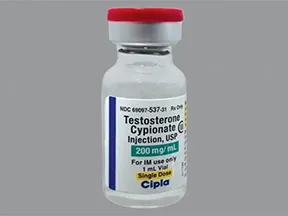 | |
| testosterone cypionate intramuscular - | 100 mg/mL vial | 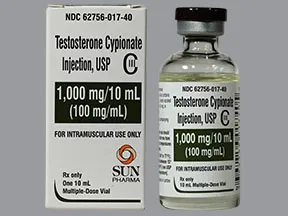 | |
| testosterone cypionate intramuscular - | 200 mg/mL vial | 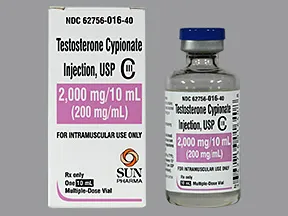 | |
| testosterone cypionate intramuscular - | 200 mg/mL vial | 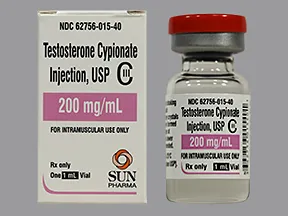 | |
| testosterone cypionate intramuscular - | 200 mg/mL vial |  | |
| testosterone cypionate intramuscular - | 200 mg/mL vial |  | |
| testosterone cypionate intramuscular - | 200 mg/mL vial | 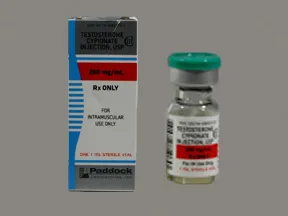 | |
| testosterone cypionate intramuscular - | 200 mg/mL vial |  | |
| testosterone cypionate intramuscular - | 200 mg/mL vial | 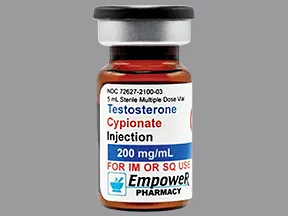 | |
| testosterone cypionate intramuscular - | 100 mg/mL vial | 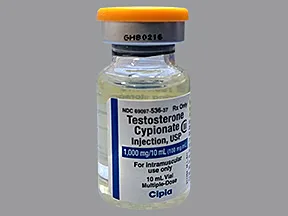 | |
| testosterone cypionate intramuscular - | 100 mg/mL vial | 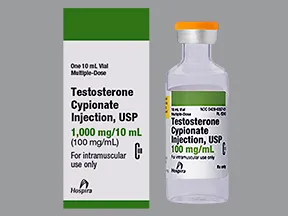 | |
| testosterone cypionate intramuscular - | 200 mg/mL vial | 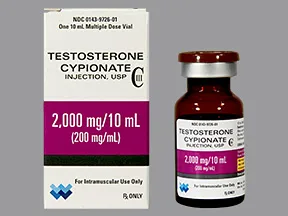 | |
| testosterone cypionate intramuscular - | 200 mg/mL vial | 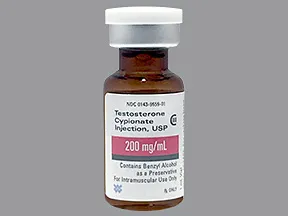 | |
| testosterone cypionate intramuscular - | 200 mg/mL vial | 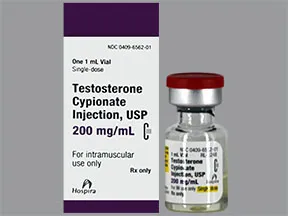 | |
| testosterone cypionate intramuscular - | 200 mg/mL vial | 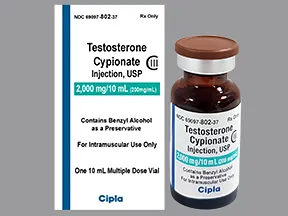 | |
| testosterone cypionate intramuscular - | 200 mg/mL vial | 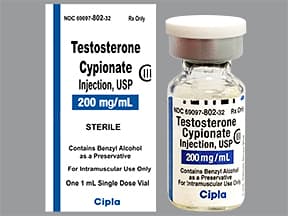 | |
| testosterone cypionate intramuscular - | 200 mg/mL vial | 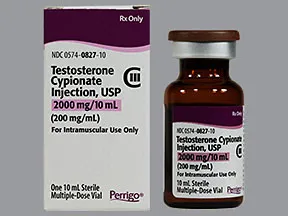 | |
| testosterone cypionate intramuscular - | 200 mg/mL vial | 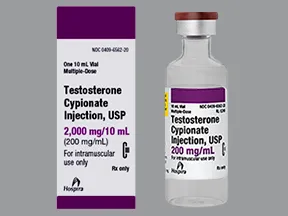 | |
| Depo-Testosterone intramuscular - | 200 mg/mL vial | 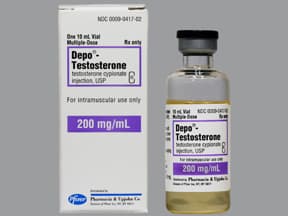 | |
| Depo-Testosterone intramuscular - | 200 mg/mL vial |  | |
| Depo-Testosterone intramuscular - | 100 mg/mL vial |  | |
| Depo-Testosterone intramuscular - | 200 mg/mL vial |  | |
| Depo-Testosterone intramuscular - | 100 mg/mL vial | 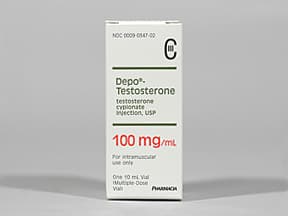 | |
| Depo-Testosterone intramuscular - | 200 mg/mL vial |  |
Copyright © 2010 First DataBank, Inc.
Patient Handout
testosterone cypionate intramuscular
TESTOSTERONE - INTRAMUSCULAR
(tess-TOSS-ter-own)
COMMON BRAND NAME(S): Delatestryl, Tesamone
USES: This medication is used in men who do not make enough of a natural substance called testosterone. In males, testosterone is responsible for many normal functions, including growth and development of the genitals, muscles, and bones. It also helps cause normal sexual development (puberty) in boys. Testosterone belongs to a class of drugs known as androgens. It works by affecting many body systems so that the body can develop and function normally.Testosterone may also be used in certain adolescent boys to cause puberty in those with delayed puberty. It may also be used to treat certain types of breast cancer in women.
HOW TO USE: This medication is given by injection into the buttock muscle as directed by your doctor, usually every 1 to 4 weeks. Do not inject this medication into a vein. The dosage is based on your medical condition, testosterone blood levels, and response to treatment.If you are giving this medication to yourself at home, learn all preparation and usage instructions from your health care professional. Before using, check this product visually for particles or discoloration. If either is present, do not use the liquid. Learn how to store and discard medical supplies safely.Use this medication regularly in order to get the most benefit from it. To help you remember, use a calendar to mark the days you will receive an injection.Misuse or abuse of testosterone can cause serious side effects such as heart disease (including heart attack), stroke, liver disease, mental/mood problems, abnormal drug-seeking behavior, or improper bone growth (in adolescents). Do not increase your dose or use this drug more often or for longer than prescribed. When testosterone is misused or abused, you may have withdrawal symptoms (such as depression, irritability, tiredness) when you suddenly stop using the drug. These symptoms may last from weeks to months.Tell your doctor if your condition does not improve or if it worsens.
SIDE EFFECTS: Nausea, vomiting, headache, skin color changes, increased/decreased sexual interest, oily skin, hair loss, and acne may occur. Pain and redness at the injection site may also occur. If any of these effects last or get worse, tell your doctor or pharmacist promptly.Remember that this medication has been prescribed because your doctor has judged that the benefit to you is greater than the risk of side effects. Many people using this medication do not have serious side effects.Tell your doctor right away if you have any serious side effects, including: mental/mood changes (such as anxiety, depression, increased anger), trouble sleeping/snoring, signs of liver disease (such as nausea/vomiting that doesn't stop, loss of appetite, stomach/abdominal pain, yellowing eyes/skin, dark urine), hands/ankles/feet swelling, unusual tiredness, fast/irregular heartbeat.Get medical help right away if you have any very serious side effects, including: shortness of breath/rapid breathing, chest/jaw/left arm pain, unusual sweating, confusion, sudden dizziness/fainting, pain/swelling/warmth in the groin/calf, sudden/severe headaches, trouble speaking, weakness on one side of the body, sudden vision changes.If you are male, tell your doctor right away if you have any serious side effects, including: trouble urinating, increased urination (especially at night), breast swelling/tenderness, too frequent/prolonged erections.Rarely, males may have a painful or prolonged erection lasting 4 or more hours. If this occurs, stop using this drug and get medical help right away, or permanent problems could occur.If you are female, tell your doctor right away if you have any serious side effects, including: deepening of the voice, hoarseness, unusual facial/body hair growth, enlarged clitoris, irregular menstrual periods.A very serious allergic reaction to this drug is rare. However, get medical help right away if you notice any symptoms of a serious allergic reaction, including: rash, itching/swelling (especially of the face/tongue/throat), severe dizziness, trouble breathing.This is not a complete list of possible side effects. If you notice other effects not listed above, contact your doctor or pharmacist.In the US -Call your doctor for medical advice about side effects. You may report side effects to FDA at 1-800-FDA-1088 or at www.fda.gov/medwatch.In Canada - Call your doctor for medical advice about side effects. You may report side effects to Health Canada at 1-866-234-2345.
PRECAUTIONS: Before using testosterone, tell your doctor or pharmacist if you are allergic to it; or if you have any other allergies. This product may contain inactive ingredients (such as sesame oil), which can cause allergic reactions or other problems. Talk to your pharmacist for more details.Before using this medication, tell your doctor or pharmacist your medical history, especially of: cancer (such as breast cancer in men, prostate cancer), blood clots (such as in the leg, lungs), heart disease (such as heart failure, chest pain, heart attack), stroke, liver problems, kidney problems, high cholesterol, high blood pressure, enlarged prostate, sleep apnea, diabetes.If you have diabetes, this product may lower your blood sugar. Check your blood sugar regularly as directed and share the results with your doctor. Tell your doctor right away if you have symptoms of low blood sugar, such as sudden sweating, shaking, fast heartbeat, hunger, blurred vision, dizziness, or tingling hands/feet. Your doctor may need to adjust your diabetes medication, exercise program, or diet.Before having surgery, tell your doctor or dentist about all the products you use (including prescription drugs, nonprescription drugs, and herbal products).Children may be more sensitive to the side effects of this drug. In children, it may affect bone growth. Check your child's height periodically.Older adults may be more sensitive to the side effects of this drug, especially prostate/liver problems, swelling of arms/legs.This medication can affect fertility in males. Ask your doctor for more details.This medication must not be used during pregnancy. It may harm an unborn baby. Discuss the use of reliable forms of birth control (such as condoms, birth control pills) with your doctor. If you become pregnant or think you may be pregnant, tell your doctor right away.It is unknown if this drug passes into breast milk. It may affect milk production and it may harm a nursing infant. Breastfeeding is not recommended while using this drug. Consult your doctor before breastfeeding.
DRUG INTERACTIONS: Drug interactions may change how your medications work or increase your risk for serious side effects. This document does not contain all possible drug interactions. Keep a list of all the products you use (including prescription/nonprescription drugs and herbal products) and share it with your doctor and pharmacist. Do not start, stop, or change the dosage of any medicines without your doctor's approval.Some products that may interact with this drug include: "blood thinners" (such as warfarin).This medication may interfere with certain lab tests (such as thyroid tests), possibly causing false test results. Make sure lab personnel and all your doctors know you use this drug.
OVERDOSE: If someone has overdosed and has serious symptoms such as passing out or trouble breathing, call 911. Otherwise, call a poison control center right away. US residents can call their local poison control center at 1-800-222-1222. Canada residents can call a provincial poison control center.
NOTES: Do not share this medication with others. Sharing it is against the law.Lab and/or medical tests (such as blood testosterone levels, red blood cell counts, liver function, blood cholesterol levels, PSA test) should be done while you are using this medication. Keep all medical and lab appointments. Consult your doctor for more details.
MISSED DOSE: It is important to get each dose of this medication as scheduled. If you miss a dose, ask your doctor or pharmacist right away for a new dosing schedule. Do not double the dose to catch up.
STORAGE: Store at room temperature away from light. Keep all medications away from children and pets.Do not flush medications down the toilet or pour them into a drain unless instructed to do so. Properly discard this product when it is expired or no longer needed. Consult your pharmacist or local waste disposal company.
Information last revised November 2023. Copyright(c) 2024 First Databank, Inc.
IMPORTANT: HOW TO USE THIS INFORMATION: This is a summary and does NOT have all possible information about this product. This information does not assure that this product is safe, effective, or appropriate for you. This information is not individual medical advice and does not substitute for the advice of your health care professional. Always ask your health care professional for complete information about this product and your specific health needs.
Formulary
Adding plans allows you to compare formulary status to other drugs in the same class.
To view formulary information first create a list of plans. Your list will be saved and can be edited at any time.
Adding plans allows you to:
- View the formulary and any restrictions for each plan.
- Manage and view all your plans together – even plans in different states.
- Compare formulary status to other drugs in the same class.
- Access your plan list on any device – mobile or desktop.





